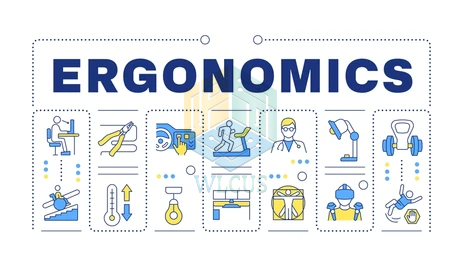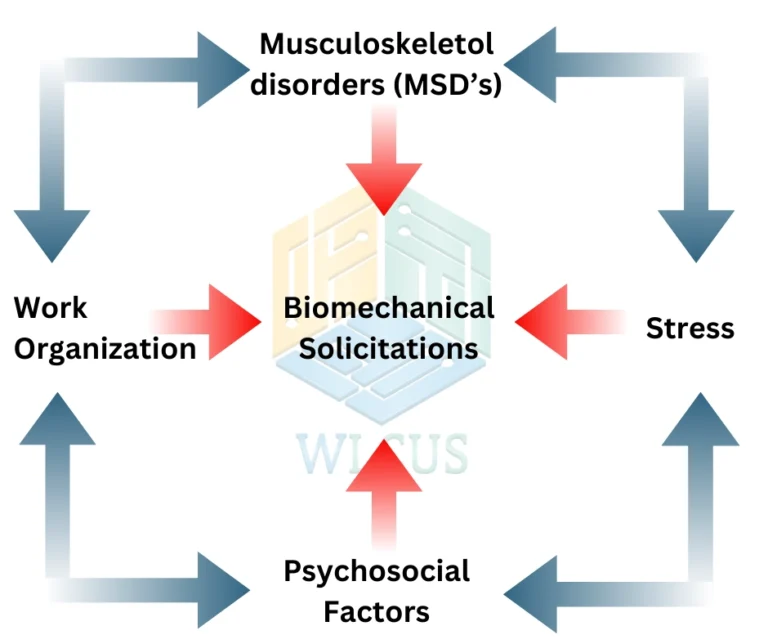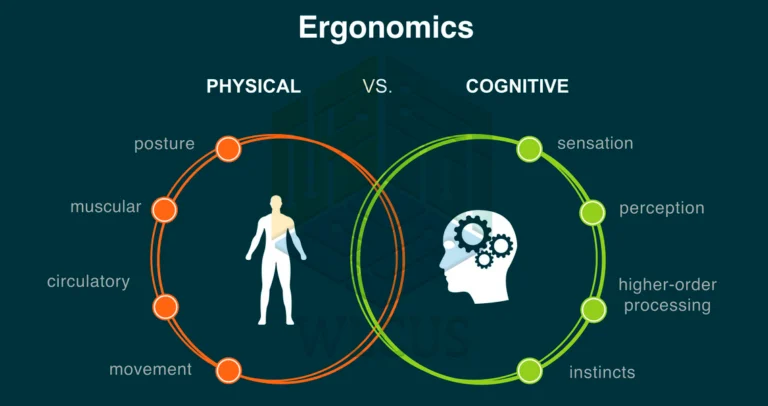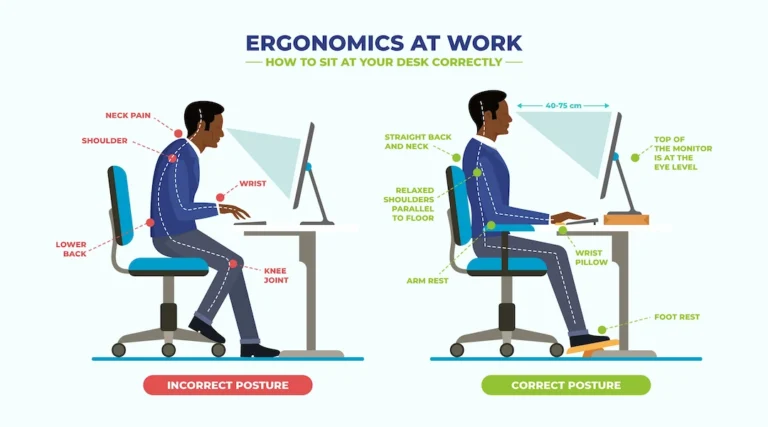The Role of Ergonomics in Mental Health and Employee Well-being
In today’s fast-paced work environment, we cannot overstate the importance of ergonomics in enhancing both mental health and overall employee well-being. As organizations strive to create a more supportive and productive workplace, they must understand the profound impact of ergonomics. When implemented effectively, ergonomics fosters a healthier, happier, and more efficient workforce, going beyond physical comfort to contribute to wellness for employees and staff wellness.

What is Ergonomics?
Ergonomics is the scientific discipline concerned with understanding the interactions among humans and other elements of a system. It applies theory, principles, data, and methods to design workplaces, tools, products, and environments that optimize human well-being and overall system performance. The primary goal of ergonomics is to improve efficiency, comfort, and safety by designing tasks, workspaces, and equipment that fit the human body’s capabilities and limitations.
Understanding Ergonomics: A Holistic Approach
Ergonomics is often misconstrued as merely adjusting a chair or desk to prevent physical discomfort. However, its scope is much broader, encompassing the design of the entire work environment to fit the physical, cognitive, and psychological needs of employees. A well-ergonomically designed workplace reduces the risk of injury, enhances job satisfaction, and plays a pivotal role in maintaining mental health.
The connection between ergonomics and mental health is profound. A workspace that aligns with ergonomic principles minimizes physical strain and fosters a positive psychological environment, reducing stress levels and enhancing mental clarity. This holistic approach, which includes ergonomic assessment and consideration of human factors and ergonomics, recognizes that the physical and mental well-being of employees are interconnected.
The Impact of Poor Ergonomics on Mental Health
Poor ergonomics can lead to a host of physical ailments, such as musculoskeletal disorders (MSDs), which are common in jobs requiring repetitive tasks or prolonged sitting. However, the impact extends beyond physical health. Persistent physical discomfort can lead to chronic stress, anxiety, and even depression. When employees are in constant pain or discomfort, their ability to concentrate diminishes, leading to decreased productivity and increased frustration.
Moreover, a poorly designed workspace can contribute to a sense of being undervalued, as it may signal to employees that their comfort and well-being are not priorities. This can erode trust and morale, leading to disengagement and higher turnover rates. Implementing workplace wellness programs that address ergonomics in the workplace can mitigate these risks.

How Ergonomics Works?
Ergonomics works by applying scientific principles to design work environments, tools, tasks, and systems that match the physical and cognitive abilities of people. Here’s how ergonomics works in practice:
Understanding Human Capabilities and Limitations
- Physical Capabilities: Ergonomics considers the human body’s strength, flexibility, and endurance, ensuring tasks do not require excessive lifting or repetitive movements that could strain muscles or joints.
- Cognitive Capabilities: Ergonomics also involves designing tasks to align with human cognitive abilities, reducing mental fatigue and errors.

Designing Workspaces and Equipment
- Workstation Layout: Arranging a workspace so that everything a worker needs is within easy reach and at the appropriate height.
- Tool Design: Tools and equipment should be designed to fit the user, minimizing the risk of repetitive strain injuries.
Task Design
- Task Variation: Repetitive tasks should be varied or include breaks to reduce physical and mental strain.
- Workload Management: Tasks should match the worker’s physical and mental capacity to avoid burnout.
Environmental Design
- Lighting: Proper lighting reduces eye strain and improves focus.
- Temperature and Noise Control: Ergonomics involves controlling environmental factors to prevent discomfort and distractions.
Training and Education
- Ergonomic Awareness: Educating workers on proper ergonomic practices, such as posture and lifting techniques, is vital.
- Behavioral Interventions: Encouraging habits like regular breaks or posture adjustments.
Continuous Improvement
- Feedback and Adjustment: Regular assessments and feedback from workers are essential to making ergonomic solutions effective.
- Technology Integration: Incorporating advancements like sit-stand desks or ergonomic software.
Outcome Measurement
- Health and Safety Metrics: Success is often measured by tracking reductions in injury rates and absenteeism.
- Productivity and Efficiency: Ergonomics can lead to measurable increases in productivity and job satisfaction.
How Ergonomics Enhances Employee Well-being
Ergonomics enhances employee well-being by reducing physical discomfort and injury, which in turn lowers stress associated with chronic pain. This improvement in physical well-being contributes to better mental health and overall job satisfaction. An ergonomically optimized environment, supported by ergo assessments, aids health and wellness in the workplace by reducing physical stress that can lead to mental fatigue and burnout.
Importance of Ergonomics
Ergonomics is crucial for ensuring the health, safety, and productivity of individuals in the workplace. According to the World Health Organization (WHO):
- Reduction in Work-Related Musculoskeletal Disorders (WMSDs): Ergonomic interventions can reduce the incidence of WMSDs by up to 61%.
- Increased Productivity: Ergonomics can lead to a productivity increase of 25-30%.
- Lower Absenteeism and Healthcare Costs: Ergonomics can reduce absenteeism by 30-40% and lower healthcare expenses.
- Enhanced Worker Satisfaction and Engagement: Ergonomically designed workplaces contribute to better comfort, reduced fatigue, and overall job satisfaction.
- Prevention of Long-Term Disabilities: Early intervention with ergonomic practices can prevent chronic health conditions and long-term disabilities.
The Role of Ergonomics in Remote Work
The rise of remote work presents new challenges in maintaining ergonomic standards. Remote workers often lack ergonomic furniture, leading to increased risks of physical discomfort and injury. This can negatively impact mental health. Organizations can support remote workers by providing ergonomic guidelines, furniture stipends, or virtual consultations with experts, which are part of a comprehensive workplace wellness program.

Implementing Ergonomics in the Workplace
Successfully implementing ergonomics requires a comprehensive approach, including ergonomic assessment, education, and ongoing support:
- Assessment: Evaluate the current work environment for ergonomic risks.
- Education: Train employees on ergonomic practices and the benefits of ergonomics.
- Ongoing Support: Provide continuous support, including periodic reassessments and updates to ergonomic equipment.
The Long-term Benefits of Ergonomics
Investing in ergonomics yields long-term benefits, including lower injury rates, higher employee satisfaction, and reduced turnover. Employees who feel physically and mentally supported are more likely to be engaged, productive, and loyal to the organization. The cost of implementing ergonomic solutions is often offset by savings in reduced absenteeism, lower healthcare costs, and increased productivity.
Conclusion
Ergonomics plays a vital role in supporting both the mental and physical health of employees. By creating a work environment that aligns with ergonomic principles, organizations can promote employee well-being, enhance job satisfaction, and boost overall productivity.
